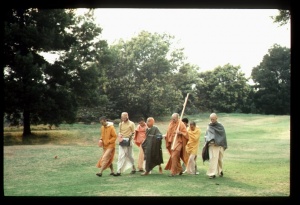CC Madhya 21.20 (1975): Difference between revisions
(Vanibot #0027: CCMirror - Mirror CC's 1996 edition to form a basis for 1975) |
(Vanibot #0020: VersionCompareLinker - added a link to the Version Compare feature) |
||
| Line 2: | Line 2: | ||
<div style="float:left">'''[[Sri Caitanya-caritamrta (1975)|Śrī Caitanya-caritāmṛta (1975)]] - [[CC Madhya (1975)|Madhya-līlā]] - [[CC Madhya 21 (1975)|Chapter 21: The Opulence and Sweetness of Lord Śrī Kṛṣṇa]]'''</div> | <div style="float:left">'''[[Sri Caitanya-caritamrta (1975)|Śrī Caitanya-caritāmṛta (1975)]] - [[CC Madhya (1975)|Madhya-līlā]] - [[CC Madhya 21 (1975)|Chapter 21: The Opulence and Sweetness of Lord Śrī Kṛṣṇa]]'''</div> | ||
<div style="float:right">[[File:Go-previous.png|link=CC Madhya 21.19 (1975)|Madhya-līlā 21.19]] '''[[CC Madhya 21.19 (1975)|Madhya-līlā 21.19]] - [[CC Madhya 21.21 (1975)|Madhya-līlā 21.21]]''' [[File:Go-next.png|link=CC Madhya 21.21 (1975)|Madhya-līlā 21.21]]</div> | <div style="float:right">[[File:Go-previous.png|link=CC Madhya 21.19 (1975)|Madhya-līlā 21.19]] '''[[CC Madhya 21.19 (1975)|Madhya-līlā 21.19]] - [[CC Madhya 21.21 (1975)|Madhya-līlā 21.21]]''' [[File:Go-next.png|link=CC Madhya 21.21 (1975)|Madhya-līlā 21.21]]</div> | ||
{{CompareVersions|CC|Madhya 21.20|CC 1975|CC 1996}} | |||
{{RandomImage}} | {{RandomImage}} | ||
==== TEXT 20 ==== | ==== TEXT 20 ==== | ||
| Line 25: | Line 24: | ||
<div class="translation"> | <div class="translation"> | ||
"Each of the cowherd boys was tending calves to the extent of a koṭi, arbuda, śaṅkha and padma. That is the way of counting. | |||
</div> | </div> | ||
| Line 32: | Line 31: | ||
<div class="purport"> | <div class="purport"> | ||
According to Vedic mathematical calculations, the following enumeration system is used: units, tens (daśa), hundreds (śata), thousands (sahasra), ten thousands (ayuta) and hundred thousands (lakṣa). Ten times lakṣa is niyuta. Ten times niyuta is koṭi. Ten times koṭi is arbuda. Ten times arbuda is vṛnda. Ten times vṛnda is kharva. Ten times kharva is nikharva. Ten times nikharva is śaṅkha. Ten times śaṅkha is padma, and ten times padma is sāgara. Ten times sāgara is antya, and ten times antya is madhya, and ten times madhya is parārdha. Each item is ten times greater than the previous one. Thus all the cowherd boys | According to Vedic mathematical calculations, the following enumeration system is used: units, tens (daśa), hundreds (śata), thousands (sahasra), ten thousands (ayuta) and hundred thousands (lakṣa). Ten times lakṣa is niyuta. Ten times niyuta is koṭi. Ten times koṭi is arbuda. Ten times arbuda is vṛnda. Ten times vṛnda is kharva. Ten times kharva is nikharva. Ten times nikharva is śaṅkha. Ten times śaṅkha is padma, and ten times padma is sāgara. Ten times sāgara is antya, and ten times antya is madhya, and ten times madhya is parārdha. Each item is ten times greater than the previous one. Thus all the cowherd boys who were companions of Kṛṣṇa had many calves to take care of. | ||
</div> | </div> | ||
Latest revision as of 13:52, 27 January 2020

A.C. Bhaktivedanta Swami Prabhupada
TEXT 20
- eka eka gopa kare ye vatsa cāraṇa
- koṭi, arbuda, śaṅkha, padma, tāhāra gaṇana
SYNONYMS
eka eka—one after another; gopa—cowherd boys; kare—do; ye—whatever; vatsa—calves; cāraṇa—grazing; koṭi—ten millions; arbuda—a hundred million; śaṅkha—one trillion; padma—ten trillion; tāhāra gaṇana—the enumeration of that.
TRANSLATION
"Each of the cowherd boys was tending calves to the extent of a koṭi, arbuda, śaṅkha and padma. That is the way of counting.
PURPORT
According to Vedic mathematical calculations, the following enumeration system is used: units, tens (daśa), hundreds (śata), thousands (sahasra), ten thousands (ayuta) and hundred thousands (lakṣa). Ten times lakṣa is niyuta. Ten times niyuta is koṭi. Ten times koṭi is arbuda. Ten times arbuda is vṛnda. Ten times vṛnda is kharva. Ten times kharva is nikharva. Ten times nikharva is śaṅkha. Ten times śaṅkha is padma, and ten times padma is sāgara. Ten times sāgara is antya, and ten times antya is madhya, and ten times madhya is parārdha. Each item is ten times greater than the previous one. Thus all the cowherd boys who were companions of Kṛṣṇa had many calves to take care of.